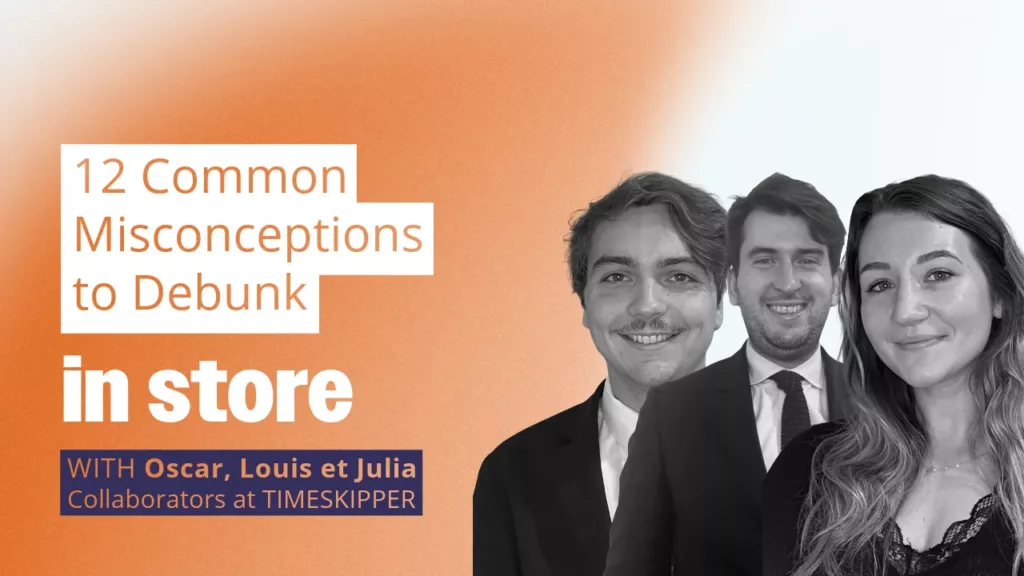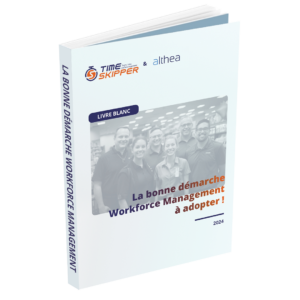In stores, everyone has their own opinion about what works and what doesn’t. But are these opinions always well-founded?
At TimeSkipper, our daily work involves staying as close as possible to the field, to store teams, and to their challenges. That’s why we asked our in-house experts Julia, Louis, and Oscar to help us separate fact from fiction.
I) Store organization model
There is an ideal model for store organization
❌ False.
Every store has its own specific characteristics: surface area, opening hours, management style, number of staff members, customer expectations, and so on. As Louis reminds us, “there’s no magic formula.” What works in a large urban hypermarket won’t necessarily be relevant for a local convenience store.
The challenge, therefore, is to analyze each store’s specific features and adapt resources and schedules accordingly.
Tools like TimeSkipper make it possible to model tasks and flows in order to build a truly tailor-made organization.
Good stock management is the cornerstone of good store organization
✅ True.
Louis points out that stock management tasks are often neglected due to a lack of time. Yet they are essential: maintaining reliable stock levels to avoid shortages, placing accurate orders, keeping storage areas tidy…
All of these factors affect the product flow in the store, which in turn drives the workload.
It’s therefore crucial to allocate dedicated and scheduled time for these tasks, just as you would for shelf stocking or customer service.
You need to track performance indicators
✅ True.
Tracking performance indicators to improve store organization and operations is even more critical today, as it is estimated that 20% to 30% of working hours are poorly utilized in stores.
Without precise KPIs, it’s difficult to make objective and informed decisions.
When it comes to store organization, we recommend focusing on four main KPIs.
Whether in food retail or specialized retail, it’s essential to monitor the percentage of poorly utilized hours. This indicator reflects how well the workload is allocated among staff present in the store. More specifically, in food retail, it’s important to track the shelf-stocking rate and the target shelving end time; in specialized retail, the focus should be on the weight of sales consulting.
The product assortment does not impact productivity
❌ False.
Reducing the assortment not only makes the product range easier to understand, but also generates savings throughout the value chain (purchasing, supply, store). However, assortment reduction must be carried out carefully and sparingly, as removing certain products for consumers can have a negative impact.
II) Store organization: food retailing versus specialized retailing
Time management is harder in food retail than in specialized retail
❌ False.
Time management is just as complex — if not more so — in specialized retail. Why?
Because, in addition to the standard tasks (restocking, receiving goods, shelving, etc.), you must also account for customer advising time — a time that is hard to compress and essential for sales conversion. Remember, a customer who is not advised is three times less likely to make a purchase.
In specialized stores, employees must juggle customer reception, logistical tasks, and product advice, often with very unpredictable customer flows.
Being able to manage customer flow is therefore crucial to maintaining a high level of service and a top-quality sales floor.
It’s not possible to determine the time needed for sales advising
❌ False.
For products that require sales advising, it is indeed possible to determine the advising time slots. How? By using timing measurements, cross-referencing historical foot traffic data with checkout receipts, and leveraging machine learning tools, it’s possible to accurately model future sales by hourly time slots throughout the day.
The goal is to capture customers who come into the store but leave without purchasing — ensuring they are advised by a salesperson and increasing the likelihood of conversion.
Employee skills are the same in food retail and specialized retail
❌ False.
Product expertise differs significantly between food retail and specialized retail.
In specialized retail, employees must have in-depth product knowledge to advise increasingly informed customers. Beyond advising, they also manage demanding product handling tasks: technical follow-up, merchandising, and detailed stock management.
In food retail, complexity is mainly concentrated around traditional fresh departments (butchery, fishmonger, etc.), where product mastery is critical: artisanal preparation, strict hygiene standards, customer relations… all skills that make these positions hard to fill.
The impact of merchandise volume is greater in food retail than in specialized retail
❌ False.
In food retail, workload is calculated more based on product families.
For example, shelving a can of vegetables does not take the same amount of time as shelving a can of fish.
Conversely, in specialized retail, although product volume is lower, the treatment required for each product (whether it needs to be put on a hanger, folded a certain way, displayed in a showcase, etc.) takes more time.
III) Recruiting and mobilizing teams
Improving organization means improving well-being
✅ True.
Better work organization also means creating a better environment in which to work.
With precise workload management by operational managers, teams know both what needs to be done, what the priorities are, and what is realistically achievable given the actual time available.
The result: better-adjusted schedules, less overload, and a healthier work-life balance.
This clearer framework, supported daily by frontline managers, also fosters greater engagement: by identifying time slots for training, distributing efforts fairly, and making the organization more transparent, we unlock powerful levers for motivation and recognition.
The manager’s role is to help employees become autonomous
✅ True.
Today, teams often feel a strong sense of autonomy, while managers emphasize they don’t have time to manage properly. As a result, employees are more abandoned than truly autonomous. Truly autonomous teams are those who know what they have to do and how to prioritize.
To make that possible, managers need to be more available — and they need tools to help them do this effectively and appropriately.
The daily briefing isn’t necessary when teams know what they have to do
❌ False.
“You don’t bring a team alive just by telling them what needs to be done,” Julia points out.
The morning briefing is a key collective ritual: it clarifies priorities, shares any unexpected changes, adjusts responsibilities, and reinforces the sense of being a united team. In short, it’s a small moment of exchange that has a big impact.
Training is the forgotten lever in stores
✅ True.
According to a survey conducted last year, 90% of managers say they don’t have enough time to train their teams, even though paradoxically, a third of them report spending too much time covering absences or replacing employees.
The result: a chronic lack of time to fully perform their managerial role — organizing work, leading teams, giving feedback, and providing training.
To break this vicious cycle, it’s crucial to free up time for management activities, allowing managers to plan tasks, structure collective moments, and schedule training sessions during identified available slots.
Effective management starts with clear visibility over the schedule.
IV) To discover : True/false for small-format stores
In conclusion: let's dare to question our certainties
These 12 preconceived ideas show the extent to which store organization is often dictated by habits… more than by facts. And yet, behind each belief lie real levers of performance: improving the quality of life at work, reinforcing operational efficiency, retaining talent or even better serving customers. At TimeSkipper, we are convinced of one thing: it’s by starting from reality, from the ground and from data that we can build an organization that is both human, agile and efficient. An organization that adapts rather than imposes, that listens rather than dictates, and that puts teams at the heart of the game.





